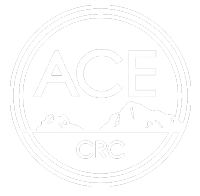About
The Antarctic Climate and Ecosystems CRC was Australia’s primary vehicle for understanding the role of the Antarctic region in the global climate system, and the implications for marine ecosystems. Our purpose was to provide governments and industry with accurate, timely and actionable information on climate change and its likely impacts.
The ACE CRC was a strong, long-standing and productive collaboration between seven core partners and fourteen supporting partners. The core partners were the Australian Antarctic Division, CSIRO, the University of Tasmania, the Bureau of Meteorology, the Commonwealth Government’s Department of the Environment and Energy (under numerous formal names over the life time of the Centre), plus the Alfred Wegener Institute for Polar and Marine Research (Germany) and the National Institute of Water and Atmospheric Research (New Zealand).
Originally established in 1991, the ACE CRC was successful in five selection rounds:
– 1991 CRC for the Antarctic and Southern Ocean Environment;
– 1996 CRC for Antarctica and the Southern Ocean;
– 2002 CRC for Antarctic Climate and Ecosystems;
– 2009 CRC for Antarctic Climate and Ecosystems; and
– 2014 CRC for Antarctic Climate and Ecosystems
Over its life, the ACE CRC attracted over $700 million in Australian and international funds in in-kind support.
This collaboration and in-kind support was vital in enabling the ACE CRC to act as the primary mechanism by which Australia’s Antarctic research sector can assemble multi-disciplinary teams of experts to address strategic science questions, particularly those relating to climate change, which cannot be tackled by one institution alone. These collaborations enabled the ACE CRC and its partners to define the agenda for Southern Ocean and Antarctic research globally and helped in establishing Tasmania as a global centre for Antarctic innovation.
The ACE CRC was established and supported under the Australian Government’s Cooperative Research Centres programme.
The ACE CRC had seven highly integrated research projects aimed at understanding how the physical environment of Antarctica and the Southern Ocean is changing, why those changes are occurring, and what the impacts are for marine ecosystems.
Project R1.1 – The Southern Ocean in a Changing Climate
This project completed the assessment of changes in temperature and salinity in the Southern Ocean, and major drivers have been identified for the changes.
Project R1.2 – Ocean forced evolution of the Antarctic Ice Sheet
This project examined the sensitivity of the Antarctic ice sheet and ice shelves to changes in the ocean heat flux, and hence the potential contribution to sea-level rise.
Project R1.3 – Sea Ice Processes and Change
This project has delivered a significant lift in understanding of the processes of sea-ice growth and retreat and potential impact on climate, biogeochemical cycling and marine ecosystems.
Project R1.4 – Antarctic Climate Variability of the past 2,000 years
This project used ice core records to reconstruct climate changes in the Antarctic region over recent millennia in order to characterise natural variability and extend the instrumental records of recent change.
Project R2.1 – Carbon Uptake and Chemical Change
This project examined whether the Southern Ocean will continue to moderate climate change via the uptake of atmospheric CO2, quantified regional and seasonal variations in the extent of ocean acidification, and examined iron supply as a limiting nutrient underpinning Southern Ocean productivity.
Project R2.2 – Biological Responses to Environment Change
This project investigated how key Southern Ocean biota respond to multiple physical and chemical changes, such as warming, acidification and changes in sea ice.
Project R2.3 – Status and Trends in Habitats, Key Species and Ecosystems
This project assessed the current status and trends of physical habitat, individual species, and Southern Ocean ecosystems as a whole, and the likelihood of future states.
Other projects
Outside of the seven research projects, the ACE CRC provided a sea ice service which prepared expert analysis and regular reports on sea-ice conditions in support of Australian and international Antarctic shipping operators, with a focus on East Antarctica and the Ross Sea. The service was provided by scientists from a broad spectrum of geophysical disciplines, including remote sensing, meteorology and glaciology and is a co-operation of the Antarctic Gateway Partnership and the ACE CRC’s sea ice group.
In 2010 the Tasmanian Government launched Climate Futures for Tasmania, a project developed by the ACE CRC to model projected changes to Tasmania’s climate during this century, and its impact on communities, industries and government agencies. The project provided the first fine-scale climate information for Tasmania by downscaling six global climate models with two emission scenarios to generate climate information from 1961 to 2100. The project interprets climate projections at a local scale, so that communities, industries and individuals can use information in their local planning and adaptation actions.






















